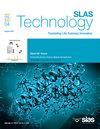High-resolution acoustic ejection mass spectrometry for high-throughput library screening
IF 2.5
4区 医学
Q3 BIOCHEMICAL RESEARCH METHODS
引用次数: 0
Abstract
An approach is described for high-throughput quality assessment of drug candidate libraries using high-resolution acoustic ejection mass spectrometry (AEMS). Sample introduction from 1536-well plates is demonstrated for this application using 2.5 nL acoustically dispensed sample droplets into an Open Port Interface (OPI) with pneumatically assisted electrospray ionization at a rate of one second per sample. Both positive and negative ionization are shown to be essential to extend the compound coverage of this protease inhibitor-focused library. Specialized software for efficiently interpreting this data in 1536-well format is presented. A new high-throughput method for quantifying the concentration of the components (HTQuant) is proposed that neither requires adding an internal standard to each well nor further encumbers the high-throughput workflow. This approach for quantitation requires highly reproducible peak areas, which is shown to be consistent within 4.4 % CV for a 1536-well plate analysis. An approach for troubleshooting the workflow based on the background ion current signal is also presented. The AEMS data is compared to the industry standard LC/PDA/ELSD/MS approach and shows similar coverage but at 180-fold greater throughput. Despite the same ionization process, both methods confirmed the presence of a small percentage of compounds in wells that the other did not. The data for this relatively small, focused library is compared to a larger, more chemically diverse library to indicate that this approach can be more generally applied beyond this single case study. This capability is particularly timely considering the growing implementation of artificial intelligence strategies that require the input of large amounts of high-quality data to formulate predictions relevant to the drug discovery process. The molecular structures of the 872-compound library analyzed here are included to begin the process of correlating molecular structures with ionization efficiency and other parameters as an initial step in this direction.
用于高通量文库筛选的高分辨率声发射质谱仪
本文介绍了一种利用声发射高分辨率质谱(AEMS)对候选药物库进行高通量质量评估的方法。在此应用中,使用 2.5 nL 声波喷射样品液滴将样品从 1536 孔板导入开放端口接口 (OPI),并以每个样品一秒钟的速度进行气动辅助电喷雾离子化。结果表明,正电离和负电离对于扩大这个以蛋白酶抑制剂为重点的化合物库的化合物覆盖范围至关重要。介绍了用于高效解读 1536 孔格式数据的专用软件。提出了一种新的高通量成分浓度定量方法(HTQuant),它既不需要在每个孔中添加内标,也不会进一步增加高通量工作流程的负担。这种定量方法要求峰面积具有高度的可重复性,在 1536 孔板分析中,峰面积的 CV 值在 4.4% 以内。此外,还介绍了一种根据背景离子电流信号排除工作流程故障的方法。将 AEMS 数据与行业标准的 LC/PDA/ELSD/MS 方法进行了比较,结果显示两者的覆盖范围相似,但吞吐量却高出 180 倍。尽管采用了相同的离子化过程,但两种方法都确认了一小部分化合物存在于井中,而另一种方法则没有。我们将这个相对较小、重点突出的化合物库的数据与一个更大、化学性质更多样化的化合物库进行了比较,以表明这种方法可以在单个案例研究之外得到更广泛的应用。考虑到越来越多的人工智能策略需要输入大量高质量数据来制定与药物发现过程相关的预测,这种能力显得尤为及时。本文所分析的 872 种化合物文库的分子结构,是将分子结构与电离效率和其他参数相关联的第一步。
本文章由计算机程序翻译,如有差异,请以英文原文为准。
求助全文
约1分钟内获得全文
求助全文
来源期刊

SLAS Technology
Computer Science-Computer Science Applications
CiteScore
6.30
自引率
7.40%
发文量
47
审稿时长
106 days
期刊介绍:
SLAS Technology emphasizes scientific and technical advances that enable and improve life sciences research and development; drug-delivery; diagnostics; biomedical and molecular imaging; and personalized and precision medicine. This includes high-throughput and other laboratory automation technologies; micro/nanotechnologies; analytical, separation and quantitative techniques; synthetic chemistry and biology; informatics (data analysis, statistics, bio, genomic and chemoinformatics); and more.
 求助内容:
求助内容: 应助结果提醒方式:
应助结果提醒方式:


